Ysart Brothers Glass, Vasart Glass Limited
by Frank Andrews
Edited by Mary Houston-Lambert
This article first appeared in Ysart Glass, Volo Edition, 1990. Updated 2002 & 2008.
It replaces the limited Ysartnews 1 article.
In September 1946, Salvador Ysart and two of his sons, Vincent and Augustine, left Moncrieff’s to start up their own factory, Ysart Brothers Glass, at the Shore Works, Shore Road in Perth. The move away from Moncrieff’s (and Paul) was necessary for several reasons, both artistic and personal; but primarily it was because Salvador was eager to restart art glass production and post-war restrictions would not allow Moncrieff’s to do so. The buildings they used had belonged to Moncrieff’s but had become disused during the thirties recession.
 |
They named the new glass Vasart from their initials ‘V’, ‘A’ and ‘S’ plus ‘art’ from Ysart. Catherine Ysart, Vincent’s wife, used acid to sign the base of each piece with a flowing script: Vasart signature illustrated on Labels and Signatures page and here. The wall vase, shown in Vasart catalogue as V026, bears the additional inscription ‘Made in Scotland’ in the same script. Initially, a circular black on white label, see labels page, was also used. Although the Ysarts did not produce a catalogue, all the shapes were given a letter and number for identification, a ‘V’ prefix denoting a vase and a ‘B’ prefix a bowl. Catherine Ysart remembers that these codes were used on the black and white label. Only a few examples of the label are known to the author, and only one of which, shown, includes a code: Y - 81 - 3/50. That code does not fit with Catherine’s recollection, as it is on a flat dish shape B002. With unmarked labels, it is possible that the ink has faded away with repeated washing as the paper was highly absorbent. Although Salvador had insisted that the new glass should be distinctly different from Monart, there is a strong affinity of shapes and styles between the production of the two factories. Also, all glass made by the Ysart family was individually blown, and none of it exhibits the precise finish of the craftsman-produced pieces from other major glass factories. Many of the workers trained by the Ysarts at the Shore Works in Perth worked or are still working at glass factories throughout Britain. The only moulds used were: dip moulds for stripes and spoke moulds for wavy edges.
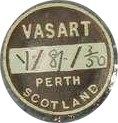 |
The first employees to join Salvador, Vincent and Augustine at the Shore Works were Bob Wishart, Harry Lever and a boy. To begin with business was brisk and by late 1949, Ysart Brothers Glass had exhibited Vasart with great success at the Scottish Industries Exhibition attended by Queen Elizabeth, mother of Queen Elizabeth II. However, production of Vasart began to decline steadily after 1950. By 1956, both Salvador and Augustine had died and Vincent found running the administration side of the business an increasingly difficult and irksome task. At this time George Dunlop of Pirelli Glass Limited, Brosnan Lane, Potters Bar, joined Vincent to set up Vasart Glass Limited at the same premises. George Dunlop had formed Pirelli Glass during 1945 and was shown in the company formation records as a Scientific Glassworker. Pirelli Glass manufactured lampworked glass animals and giftware glass and had first become involved with Vasart through the paperweights, which they helped to market. Many of the decorating contracts for the souvenir trade had come to Vasart through George Dunlop.
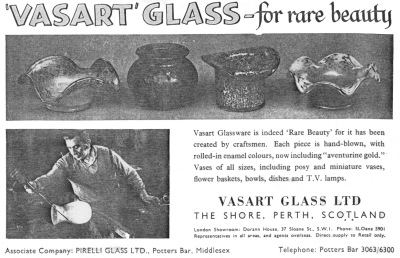 |
| Advert Pottery Gazette and Glass Trade Review, June 1957. Showing Vincent making a vase. |
The Ysart family were all gifted musicians and enjoyed evenings at home playing both guitars and mandolins. Amongst themselves they spoke Spanish but all spoke good English with, to an English ear, strong Scottish accents! Vincent and Antoine were the keenest musicians and both played in a local dance band ‘The Victoria Dance Band’ giving many concerts for the YMCA. Vincent played saxophone, violin and clarinet and Antoine, piano and accordion. Paul’s son Salvador recalls that he wrote to Vincent asking if the band would play for his Cadets’ party one year and Vincent replied that he would be happy to do so and attached a list of the band’s fees.
 |
After the company was renamed, the signature was quickly discontinued, being replaced by a shaped black and silver label applied to the side of the piece, see labels page; note that Pirelli used the same label design. It is not unusual to find examples bearing this label. However, a few pieces have been seen with both a signature and the black and silver label. As a side-line to normal production runs, Vasart Glass decorated ready-supplied glassware for Pirelli: Martini glasses ‘Just by itself or on the rocks’ glasses, shown in Vasart catalogue as D001 & D002, Babycham champagne glasses (D003) and souvenir glasses with a lion transfer and town name. Workers at Vasart Glass included Joe Dickson, grinder; Jack Allan, blower; Pat Allan, Nelly Reed and Catherine Ysart, finishers and paperweight assemblers. Joe Dickson looked after the ‘annealing tunnel’, which was constructed from corrugated iron with milk crates to hold the pieces. The finished pieces spent about a week being pushed slowly along the tunnel. When they reached the far end, Joe ground the bases and Catherine signed them, after which Joe packed the individual orders.
In 1960 Stuart Drysdale, a local lawyer, was brought in as manager of Vasart Glass; he became a director in 1961. During 1963 the Prime Minister, Sir Alec Douglas-Home, commissioned the Vasart factory to produce lighting globes in various sizes for Downing Street. Jesus Braso was persuaded out of retirement to help Vincent. Twenty large globes were produced for the Cabinet room at 10 Downing Street, with another 135 in smaller sizes for use in 10, 11 and 12 Downing Street. The large globes required up to 11 men to manhandle each one and it took about 45 minutes to make one. They each cost about £400 to produce, and as they were sold for £150 the loss to the company must have been substantial. Later, when a change of Government caused their removal, some of the globes were shipped to the USA but, due to vibrations and bad packing, all had been shattered by the time the consignment arrived. A photograph of the Strathearn showroom on page 39 of Ysart Glass shows some of the globes; and one now hangs in the Perth Museum. The moulds for the large globes had been cast by the Perth Foundry and turning was done by Roberston & Hunter.
On a visit to New York in 1963, Mr A K Bergius of the whisky distillers William Teacher & Sons was given a Teacher’s Whisky bottle which had been accidentally left overnight in a potter’s oven, giving it the appearance of having been squashed. The squashed bottle made a good ashtray and, on his return, Mr Bergius showed it to almost every glass manufacturer in the country. No manufacturer was willing to try and reproduce the design until it was taken to the Vasart works. Vincent agreed to attempt to reproduce the ‘accident’ and spent many long evenings preparing and experimenting with a special furnace with bricks and gas jets until eventually he was successful. One ashtray, given to the author by Catherine Ysart, came from the very first successful batch made by Vincent. The ashtray is shown here and is catalogue item D005, together with some later variations, D006 & D007. Production of the ashtrays reached about 500 per month and Teacher’s, finding them popular, wanted more for publicity purposes. Realising that the Vasart premises were not suited to an increase in capacity, it was decided in 1964 that Teacher’s would take over Vasart Glass Limited and build a new, larger glassworks, renaming the company Strathearn Glass. The Shore Road works, with twelve glassmakers, finally closed on 26th December, 1964.
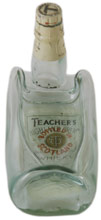 |
VASART GLASSWARE
The major difference between Monart and Vasart is in the range of production colours, while many new shapes were developed by the Ysarts free from the constraints of Mrs Moncrieff. The difference in colours between the two types of glass, while partly due to post-war supply problems, does indicate the changing artistic tastes evolving during the immediate post-war period. The strong, powerful and dramatic colour schemes popular in the homes of the 1930’s were being replaced by more delicate, softly muted colours, and much of the Vasart production reflects this change. Monart also added some pastel shades to their range during this period, but the colours were brighter and less subtle than the Vasart pastels.
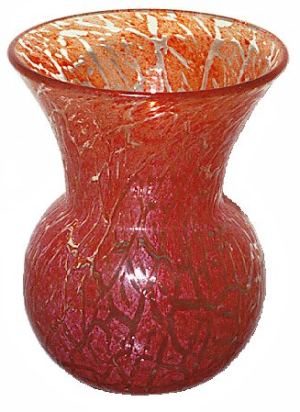 |
| Vasart Cloisonné vase shape V009. 7¼" 181mm high. Clear inner, surface decoration red with white. This is one of only a handfull of surface decorated Vasarts I have ever seen. See another is shown in the lamp catalogue as L006. |
While some early Vasart production used colours and gold aventurine brought with the Ysarts from the Moncrieff factory, the supply was limited and they were soon forced to find other sources. The family were well versed in the chemistry of glass and purchased raw chemicals to make their own colours. Vincent Ysart’s recipe book has survived and is in the possession of his family but, unfortunately, could not be obtained for reproduction. One of the Vasart colour enamel suppliers was an English firm Wengers Ltd, Etruria, Stoke on Trent, the first manufacturers of glass enamel in the UK. It is now merged with Harrison Meyer and Podmores into Potterycrafts.
One common Vasart colour scheme used a lighter shade at the bottom of the piece with a darker one towards the top. At the point where the two joined, swirls were added in one or more contrasting colours. On the best examples of this type, the swirls are regularly worked and very distinctive. In the early years, the Ysarts often used pieces of cane around the centre of vases where the upper and lower colours met. Sometimes the canes are clearly recognisable, but they usually appear as vague splashes of colour. The canes can be useful in helping to identify Vasart paperweights. One remarkable piece of Vasart exists with all-over decoration of filigree canes, see “The Vincent Ysart Vase” on the specials page; it was made by Vincent as a special gift for his wife.
As well as a wide range of vases, bowls, fruit sets, ink bottles, etc., Vasart produced various types of lamp, including some attractive mushroom lamps with fittings made from thick brass wire. One of the bases was made from a double globe, but most are similar to the Monart mushroom lamps. The factory also made a range of cheaper, more practical table lamp bases, designed to be used with either fabric or parchment shades. The cone- and thistle-shaped bases are the most common types, and these are all shown on the lamps catalogue page. All these lamps were identified by names rather than codes and the thistle-shaped lamp is known to have been named ‘Balmoral’. A popular type of Vasart lamp, known as the tulip lamp Shape L001, looks like an inverted flower with a petal-shaped top edge and is illuminated from inside. All the lamps were produced in a wide variety of colours and, apart from the mushroom lamps and cone-shaped bases, were later in production at Strathearn. A Vasart lamp usually had the hole for the electric flex skewered while the glass was still hot, or the foot was folded to create a narrow tunnel. A few examples of Vasart lamps have been found with a clear glass collar fitted over the hole to prevent chafing and also to strengthen the hole. The wall vase, Shape V026, has such a collar attached to its hanging hole. The most common types of Vasart are small ashtrays and bowls with decorative, wavy-edged rims formed by pressing the rims against spoked wooden wheel forms. Miniature vases in various shapes are also frequently found, as are the baskets B003, B005 and B028; but large baskets are less common.
THE PAPERWEIGHTS
The philosophy of paperweight production at the Vasart factory was completely different from that of Paul Ysart. Paperweights were not seen as ‘art’ objects but as a sideline which was popular with the gift trade, their main outlet. Many Vasart weights are quite crude, and assembly of the canes was mostly undertaken by women who were given a free hand in the individual designs. Catherine Ysart and Jack Allan’s wife, Pat, in addition to several other women, worked on paperweight production. The canes were laid out by the women working in a caravan parked next to the Shore Road Works and not, as rumoured, by outworkers. When an additional shed was built for decorating, this was also used for paperweight assembly. The handful of high quality Vasart weights that survive were produced completely by the Ysart men themselves and also by Jack Allan. A ‘Y’ cane has been attributed to Salvador Ysart but it could also have been used by Vincent Ysart. Production was not limited to paperweights alone as smaller weights were used to decorate corkscrews, letter openers, car gear stick knobs and a bar set, see the weight decorated page. Normal size weights were glued to brass door handles and some giant size weights were made as door stops. The weight shown on the paperweights catalogue page, PV001, has a raised garland of filigree canes and this is a common feature in some of the better quality weights produced at the Shore Works. Ink bottles with coloured centres, unlike Paul Ysart’s which were always clear, were popular products and often of above average quality. One visitor to the Shore Road Works was an English professor buying millefiori objects for a museum. He had bought several weights (described as ‘English c. 1850’) from antique dealers but, having started to find identical weights with increasing frequency as he travelled North, he realised that they must be new and set about discovering the factory.
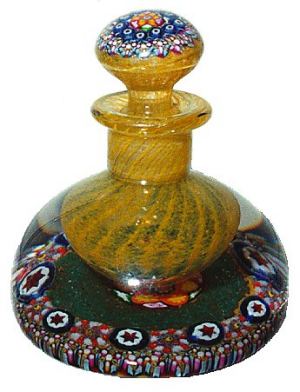 |
|
Vasart ink bottle. 112 mm high. |
Occasionally found with the black and silver paper label, these weights can only be identified by the colours used and by the association of canes with others that have been identified. Comparison with labelled Strathearn weights is another good way of identifying them. Hopefully, the cane samples and catalogues on this site will help to bring to light many more examples than are currently known. The cane samples show some of the best canes used by the Vasart team. The dark tinted glass characteristic of Monart paperweights has been found in some Vasart weights, but most are made with a much clearer metal. The bases of Vasart weights have a snapped-off pontil mark and the minimum of grinding. Strathearn continued to produce weights for the gift trade but the change of location brought about a change of glass chemistry, and these weights are easily detected by the different range of colours and a strange ‘dry’ appearance when compared to the canes in their earlier work. This may be because the colours caused problems when encased in clear glass, which had a higher lead content than that previously used by the Ysarts.
Research into Vasart and related weights continues. There is discussion about which were made by Ysart Brothers Glass and which by Vasart Glass Limited: the main indicators of the earlier period are the “Vasart” signature, the black and white circular label and an acid etched “Ysart Bros.” signature, but both of the latter two are rarely found. Research with UV light may produce a more accurate way of dating the Vasart paperweights. After leaving Strathearn, Vincent Ysart continued to make weights which included Vasart canes, until his death. The canes on the sample page came from the stock he used. There is one big difference: they were made using a cold casting resin. To date, I have not heard of one of these on the market.
The original Vasart buildings were bulldozed into the river. On one 1980’s visit to Perth, I found a lump of slag glass on the shore by the site where the works had stood. At this point, the River Tay has a very fast current and any attempt to examine the river bed would be very dangerous. The Tay produces delicate pink pearls and I could not help wondering whether a piece of millefiori carried by the swift current ended up in an oyster to form the first Ysart pearl!
The Monart & Vasart Collector’s Club constructed a catalogue of shapes produced by the Ysart brothers in the Vasart period. This work has now been extended on this website, see the Overview.
Vasart glass is often regarded, rather unfairly, as second rate by some avid collectors of Monart. As with any collectible item, individual taste plays an important role when forming a collection. Although many pieces may be seen as pale reflections of the strength and boldness of Monart, many glass collectors show a distinct preference for the subtle pinks, blues, and greens of Vasart. The family were in love with their art, and it is with the death of Vincent Ysart that this chapter closes.
Reproductions
Perthshire Paperweights Limited, in the 1980’s, were reproducing Monart and Vasart style pieces, including tulip and mushroom lamps. In most cases the colours are of a completely different nature and should give no cause for confusion. The bases of the reproductions occasionally have a pontil and are frequently marked with a vague impressed ‘P’. Stuart Drysdale of Perthshire Paperweights wrote to me that a quantity of ‘seconds’ lamps without fittings were sold by them to an antique dealer for export to Spain, but these subsequently reappeared in Great Britain, with the addition of old fittings and described as Vasart. The reproductions have a drilled hole or a channel ground into the base to accommodate the electric flex, unlike the original lamps which have the base rims lifted to accomodate the flex. However, some vases are being made with a flower incorporated into the design, adding a new dimension to the style that is unique to Perthshire Paperweights. All these pieces were being made by Chic Young who had worked as an assistant to Paul Ysart at Moncrieff’s.
References
- ‘Glass Blower to the Cabinet Room.’ Monica Sharon, March 1986, Scottish Home & Country Magazine, Scottish Women’s Rural Institutes, Edinburgh, Scotland. Monica Sharon based her article on interviews with Catherine Ysart.
- Brian J. R. Blench, Scottish Glass 1945 to the present day. Journal of Glass Studies, Vol.25, 1983, p.208. The Corning Museum of Glass, Corning, N.Y.14831
- A signed Vasart bowl coloured in the classic Monart style of black and dark green with gold aventurine has survived. The shade of green is identical to that of much pre-war Monart and, as this colour was unobtainable after the war, would suggest that its source was Moncrieff’s.
- A photograph in the Perth Museum shows Jack Allan assembling a weight. Ref No. 1987.30.14.
- Perth newspaper, Courier & Advertiser 3rd December 1963. Downing Street Globes.
- Perth newspaper, Courier & Advertiser Supplement 14th August 1961. Vasart glass article: “All the World Admires Their Art in Glass”.